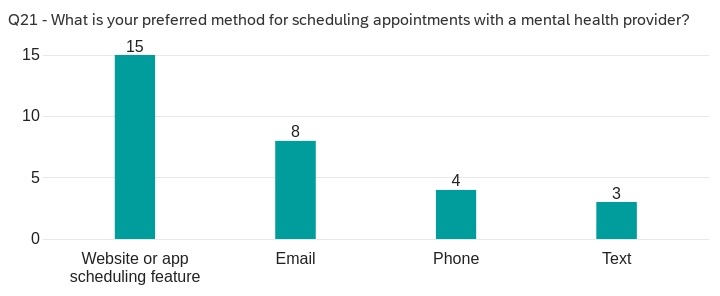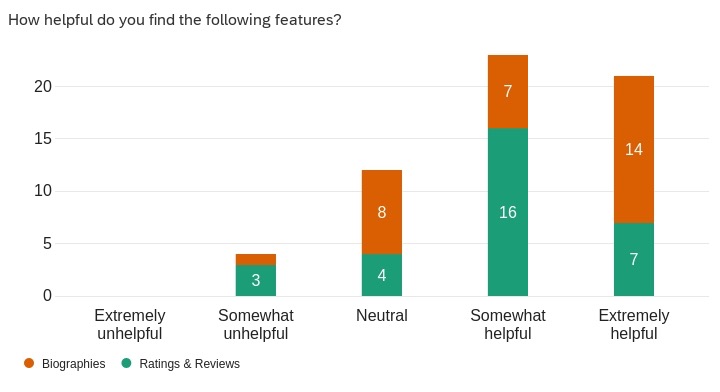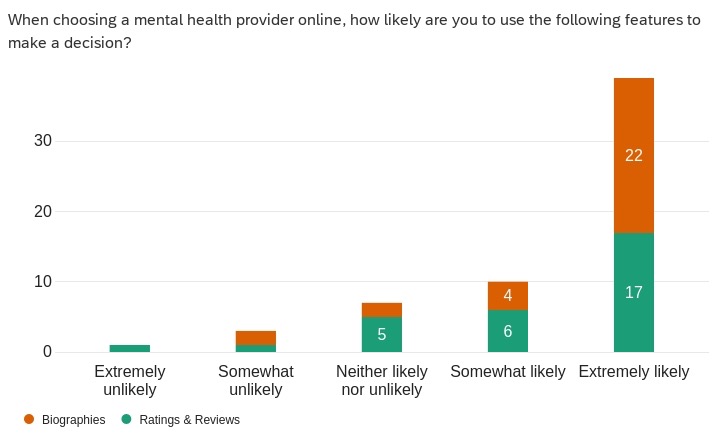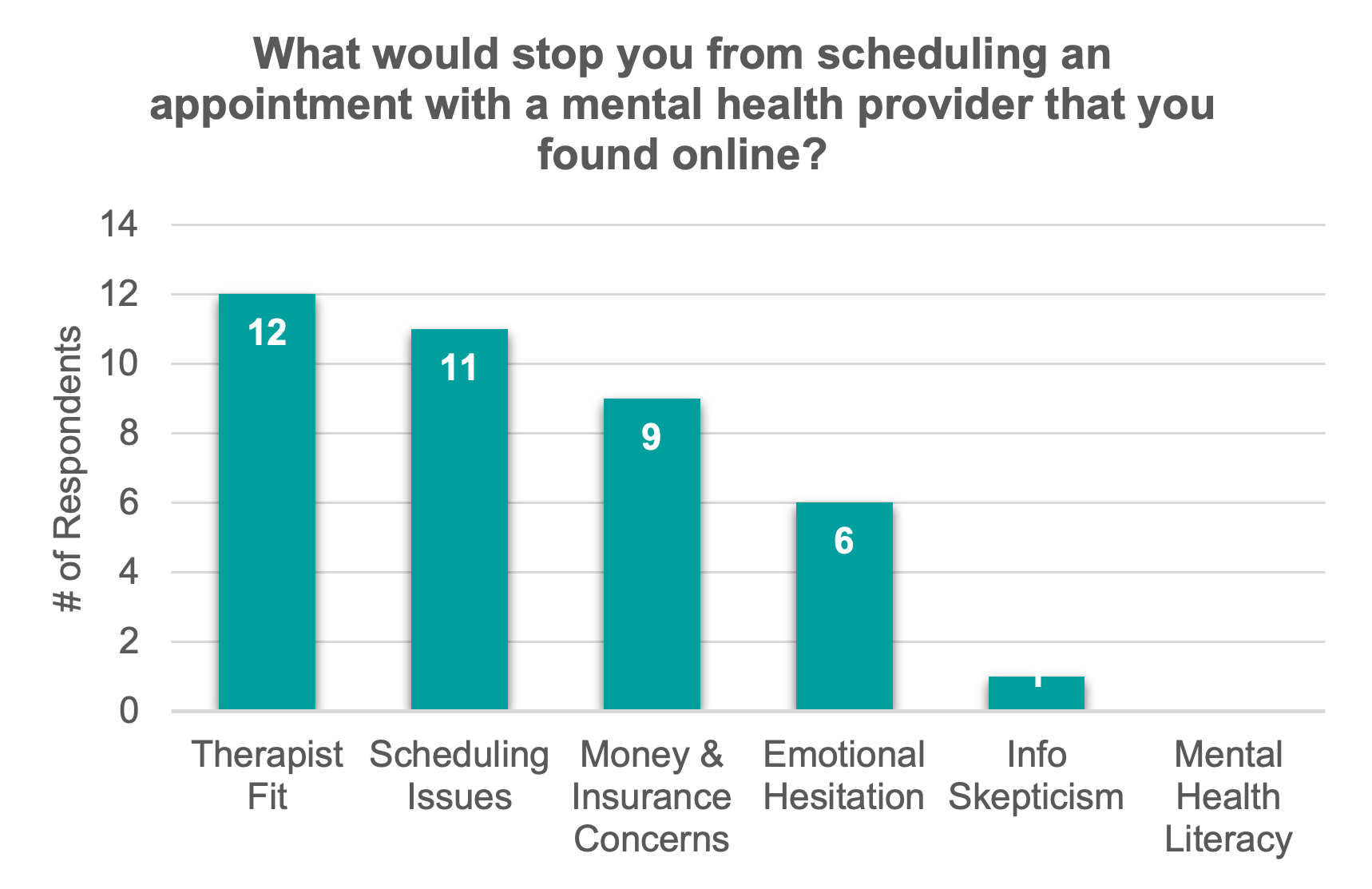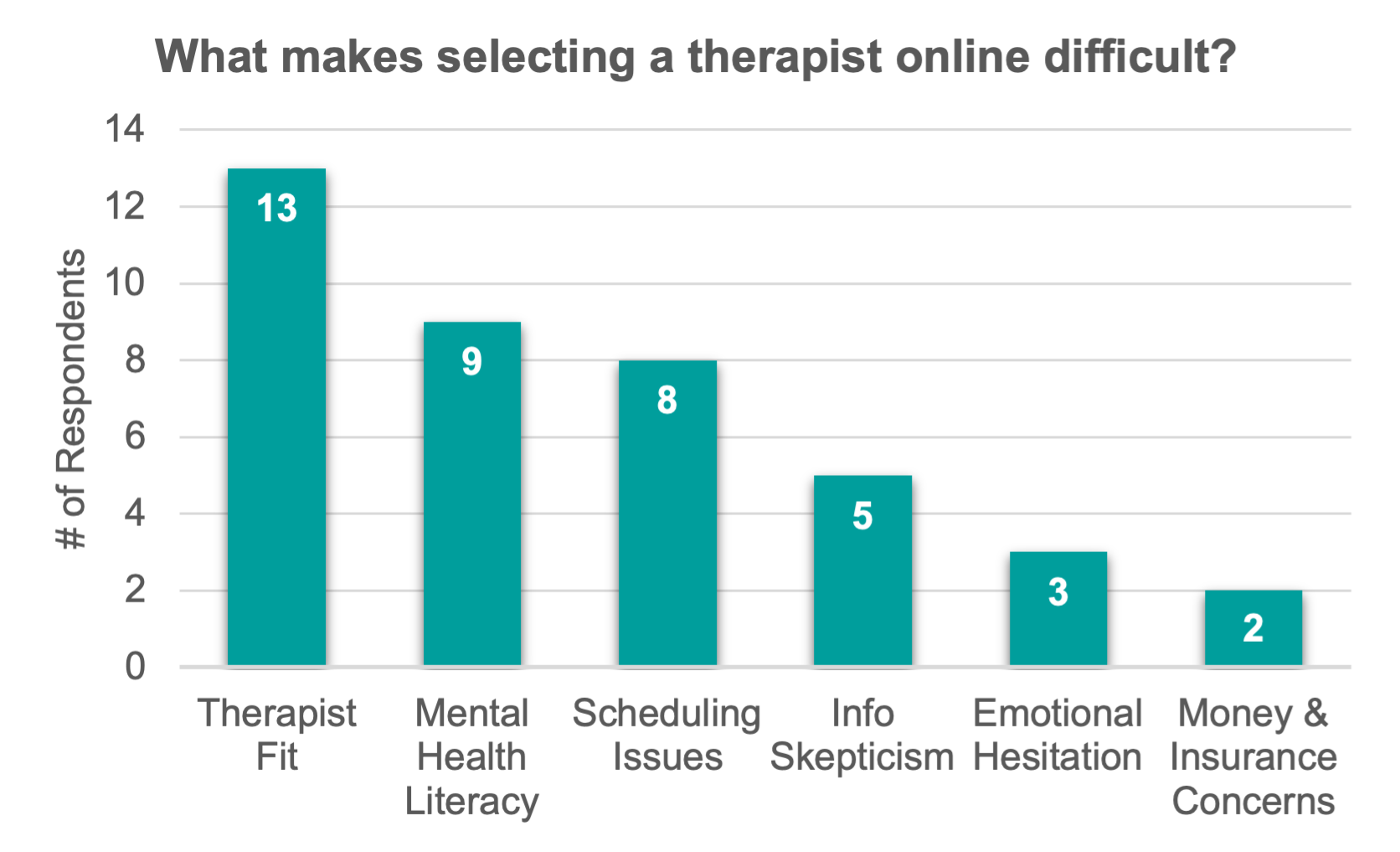WellMind
Overview
This project was inspired by the increase in demand for quality mental healthcare spurred by the COVID-19 pandemic. Ultimately, this data was assembled into recommendations for a website/app solution called WellMind that helps users find therapists to meet their needs. This solution was created as a student project. WellMind is a fictional product.
Contributions
Research Role: One of four UX Researchers in a shared academic project
Responsibilities: Contextual inquiry, interviews, inductive coding, survey creation and distribution, user scenarios and future design implications
Research Duration: January 2022 - March 2022
Tools: Miro, ATLAS.ti, R statistical software, Qualtrics
Design Role: Sole designer ideating, creating, and testing prototype design
Responsibilities: Conceptualize wireframes and prototype design, test design with users, iterate upon test results
Design Duration: June 2022 - ongoing
Tools: Adobe XD
Process
Research - Observe - Interview - Survey - Inform Design
Our process began with researching the domain of mental health online resources and provider directories. Based on our research, we developed fundamental research questions and our overarching project goals. We then conducted observations by following a contextual inquiry framework. These were followed by interviews with users. Next, we developed a survey to test our hypothesis and findings from the previous interview and observation methods. Lastly, we synthesized the information from all of our data into design implications. These implications informed the recommended design for the app/website, WellMind.
Research
Literature
Our research was largely focused on exploring how people currently explore mental health topics online. In our research, we found two main types of sites - mental health provider search directories, and informational self-help resource pages. For further exploration, we framed our research questions to investigate how people use these two different types of sites.
Research Questions
- How do users leverage online resources to research mental health conditions and seek professional help for mental health?
- How can a technology-based solution improve the process of searching for resources and seeking professional help for mental health?
Observations
Methods
To better understand how users currently utilize mental health resources online, we conducted observations of eight participants ranging from ages 23 to 34 who expressed interest in using online resources to research mental health. Participants completed a scenario-based task to search for professional help to resolve issues related to stress at work. All but one observation took place virtually. Observation were conducted using a Contextual Inquiry format.
The observation protocol can be viewed through this link
Findings

We shared notes from our observations by creating an affinity diagram.
Observations were coded using ATLAS.ti software and an AEIOU framework for creating tags.
View Miro Board
The affinity diagram exercise helped us hone in on common themes among our interviews. The most salient themes were described as such:
- Feature Focus - Users manipulated of filters (gender, treatment, insurance), location maps, biographies, ratings.
- Licensing Credentials - Users commented on licensing of provider's (LICSW, LMFT, etc). Knowledge of licensing varied greatly between users.
- BetterHelp - Several users interacted with BetterHelp, including filling out a symptom questionnaire.
- Research First - Some users opted to research before selecting a provider. Users Googled coping skills specific to the scenario. Some users searched for treatment specific to Anxiety and Depression.
- Barriers - Insurance and cost of treatment appeared to be a concern for most users. Location was an additional barrier for users living in remote areas who wanted in-person treatment options.
Interviews
The interviews were intended to further inquire into the themes that emerged during our observations. Our questions were categorized into several themes: Research, Determining Initial Criteria, Evaluation, and Making Final Selections.
Because our observations used a fictitious scenario, we wanted our interviews to reflect a more personal experience. To do this, we asked participants to recall a time they searched for therapy for themselves or a loved one. This was included in the screening criteria, so participants were made aware of this requirement in advance.
Methods
We then conducted eight interviews to better understand the motivations, barriers, and challenges facing users engaging with online mental health resources. Interview participants were screened according to use of online mental health resources in the last 12 months. Participants were asked questions regarding their research approach, what criteria they found important when selecting a therapist, and what challenges they faced when searching online for a mental health provider.
The interview protocol can be viewed through this link
Findings
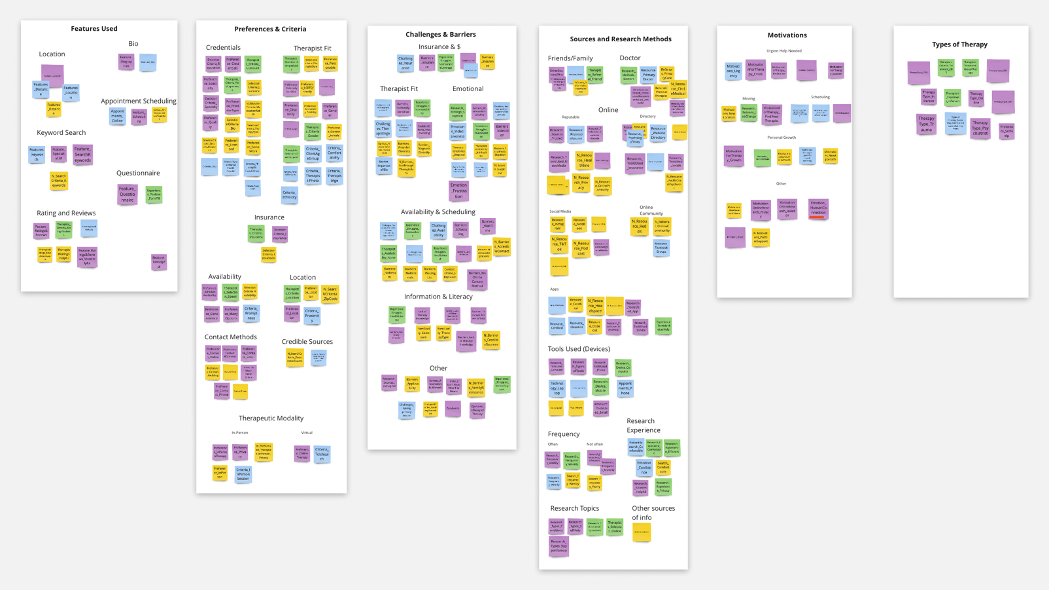
We assembled our notes into ATLAS.ti, coded segments, and then shared our codes with each other in a Miro board. This board is divided into themes that outline major common findings from our interviews.
View Miro Board
Research Methods - Results showed that frequency in searching for mental health topics online varies greatly by the individual. Some users investigated online sources before searching for a mental health provider, and some used resources in conjunction with their search. Half of the participants asked family, friends, or a healthcare provider for recommendations for mental health help.
Features - All participants reported engaging with online reviews and ratings of practitioners. Some participants doubted the credibility of these review systems. Participants reported using biographies to aid in therapist selection.
Preferences - Individual preference appeared to greatly influence therapist selection. Some users voiced preference for in-person therapy, and therapists who are inclusive of gender, race and sexuality.
Challenges - Insurance, understanding of mental health terminology (mental health literacy), distrust of online information, were all reported barriers that prevented individuals from selecting mental health providers.
Survey
Findings from the interviews were further explored through a survey. The survey aimed to investigate the importance of several key features mentioned during the interviews and observations - including filter criteria, biographies, scheduling, and ratings and reviews.
Methods
Lastly, we created a survey to explore users’ approaches to research, engaging with filters, selection criteria, scheduling preferences, and personal demographics. We used the same screener as mentioned with the interviews to determine inclusion criteria.
The survey was created to test our hypothesis:
Users who have done less self-help research will find it more difficult to pick a therapist online
- Independent Variable: Level of self-help research
- Dependent Variable: Difficulty of finding a therapist online
- Statistical Test: Mann-Whitney U
The survey was created using Qualtrics and distributed through the DePaul University College of Digital Media participant pool and social media sites.
The survey protocol can be viewed through this link
Findings
After performing statistical analysis, our hypothesis was ultimately rejected - there was no significant difference in amount of self-help research done and difficulty finding a therapist online. Despite insignificant results from our hypothesis, the survey revealed interesting trends in features that users value and potential barriers in online mental health resource websites.
The graphs below resemble several key findings that were considered along with our data from observations and interviews. Ultimately, these graphs helped us reflect and synthesize our data into concise themes.
Summarized Themes
After completing the survey, we combined the findings from survey, interview and observation data to form the following summative themes:
- Self-Help Research and Mental Health Literacy - Users engaged in self-help research to inform their search for mental health providers. Users sourced information from medical sites regarding treatment, and symptoms, and even used social media for "hacks" and coping mechanisms.
- Features - Users interacted with search features such as filters and maps to fine-tune their result list of providers. Then users further engaged with specific profile features such as biographies, ratings and reviews, to help select a provider that met their needs.
- Preferences - Some users preferred therapists with specific qualifications, such as licensure and training in relevant issues (LGBTQIA+ identities, cultural competency, specific disorders, etc.)
- Challenges - Therapist fit was the primary challenge that faced most users. Insurance and scheduling closely followed therapist fit.
Design Implications
Synthesizing data from our observations, interviews, and surveys resulted in the following implications for design. These recommendations are intended to meet user needs as described in our research findings.
Search/Compatibility Features
Findings from the observations, interviews, and survey revealed that provider compatibility is important to many participants. Our data showed that most participants interact with filter criteria to find a therapist that aligns with their personal identity and values.
Compatibility Questionnaire
Our survey showed the ability to discuss physical health and disabilities, therapist gender, and LGBTQIA+ issues are the most important for determining cultural or personal fit with a therapist. An optional compatibility questionnaire allows users to indicate which aspects of their identity they want to align with their therapist.
The questionnaire will allow users to indicate their preferences regarding a therapists' style, cultural background, personality, and other factors that are important in the therapeutic relationship. After completing the questionnaire, users will receive a list of therapists that match the responses they provided.
Selection/Profile Features
Wanting to know more information about the therapists' style, credentials, and approach to therapy were all common findings mentioned by participants throughout the observations, interviews, and survey. Our findings suggested that users need a designated spot to find provider information. Our data supports the need for a standardized profile that contains information regarding insurance, contact information, and the following areas described below.
Certifications and Specialties
In observations and interviews, participants actively looked through providers’ credentials to get a sense for areas of expertise. In interviews, several participants mentioned being skeptical providers' credibility in listed areas of expertise. Survey results showed the type of issues a therapist specializes in are the most important criterion in determining therapist fit.
Documentation regarding which conditions providers specialize in and what therapeutic treatments they offer will also be highly visible (including specified training, licensing, and education). This information will contain built-in explanations of licensing and credential terms to promote mental health literacy and informed decisions. Providers will list their specialty areas with supporting evidence of training in this area, and their defined approach to treating specific diagnoses.
Detailed Biographies
All participants reported reading and making decisions based on provider biographies. Interview results showed that many participants seek out LGBTQIA+ allied providers. Results from the survey showed that respondents found biographies to be the most helpful feature when searching for a provider online.
Providers will include a detailed biography that outlines their approach to therapy. Reading a biography written by the provider allows the user to get a sense for that practitioner's approach to treatment and determine compatibility. Biographies will also provide information about any specific populations (such as BIPOC or LGBTQIA+) the practitioner serves to further allow users to determine fit. Within the biographies section, therapists will have the option to record a video to help introduce themselves. Therapists will also indicate if they allow a free consultation to help gauge fit.
Ratings and Reviews
In the observations, several participants used ratings and reviews to select a therapist. Interview participants mentioned that ratings and reviews were a key feature used to rule out providers. In the survey, ratings and reviews were rated as “somewhat important”, with most users rating biographies as more important.
In this feature, users will be able to leave reviews and ratings of providers. Users will maintain anonymity in their feedback, and content moderation will exist to reduce spam and illegitimate reviews.
Scheduling Features
Scheduling was discussed among participants throughout the observation, interview, and survey processes. Convenience appeared to be an important factor in determining preference for scheduling appointments.
Scheduling Calendar and Online Appointment Request
Most participants preferred scheduling their appointments online. In addition, some participants mentioned wanting to know the length of a providers' waitlist to estimate when they can be seen. Survey results showed that online scheduling was preferred by most participants. This further supports the need for visible online scheduling solutions.
Users will be able to make online appointments at their convenience using a scheduling calendar. Providers will include an updated scheduling calendar that will be visible on their profile. The scheduling calendar should also send appointment confirmations once the user has scheduled an appointment. If appointments are not available, users can add themselves to a waitlist.
Community Features
Getting opinions from peers through online resources was repeatedly mentioned in our data. In observations and interviews people describe engaging with message boards or forums to get information on specific issues and diagnosis. Information from the survey showed that individuals like the anonymity of online resources over asking a medical professional or a friend about mental health topics.
Community Message Board
Our findings show that participants prefer online resources when seeking mental health information. Survey results showed that 90% of participants use online sources compared to 50% using advice from medical professionals and 43% using friends. In the observations, participants often used additional resources to gather information on mental health topics before searching for a therapist. In interviews, some participants described social media as a supplemental source of mental health information.
A message board will allow users to post about certain topics and leave feedback on others' postings. The board will function with anonymous usernames, to reduce privacy concerns.
Designs
Landing page
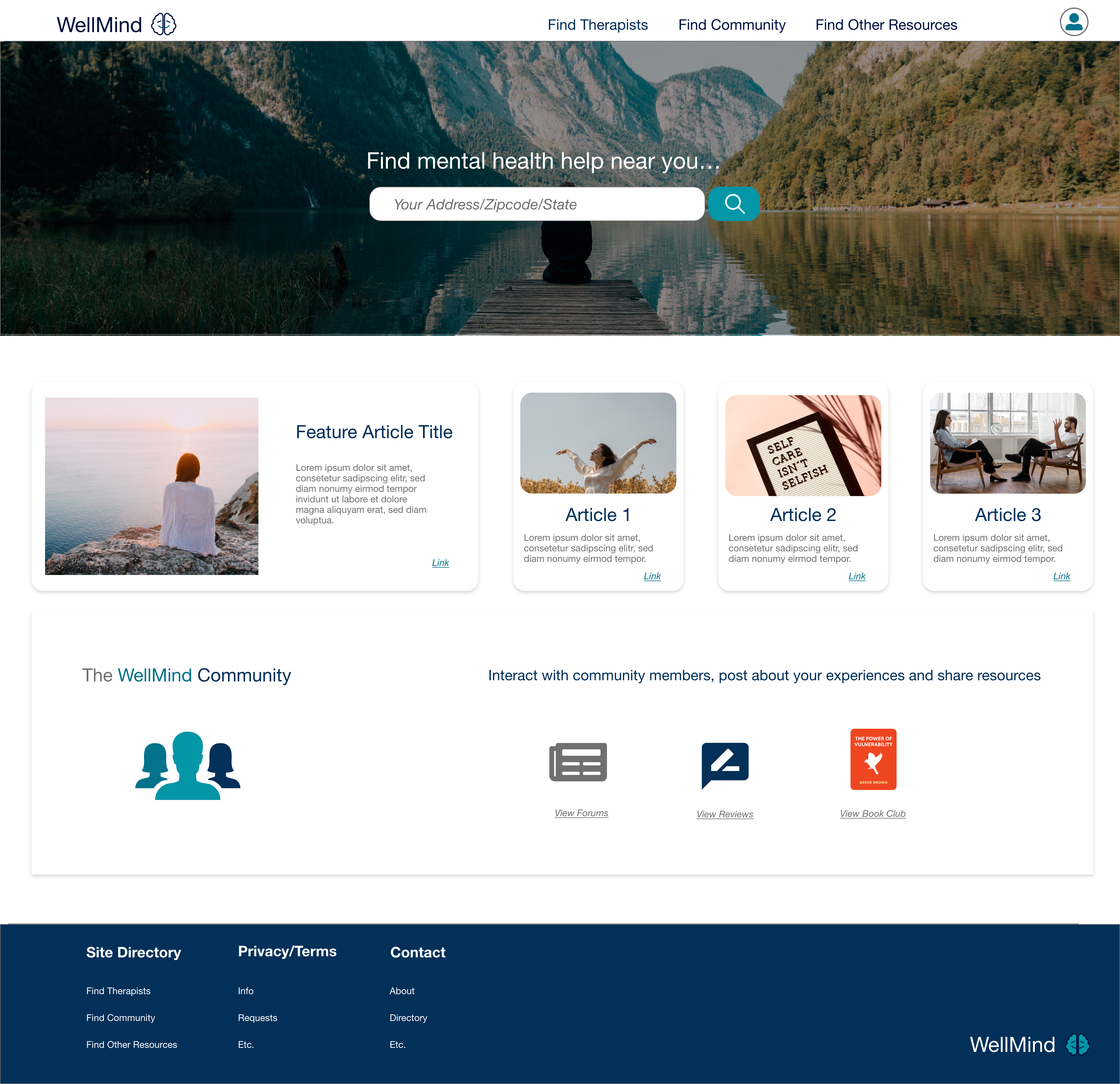
Goals
- Advertise community groups and opportunities for engagement
- Provide relevant mental health related feature articles on main page
- Give users freedom to search in a way that works for them - location
Find a Therapist

Goals
- Advertise compatibility questionnaire
- Educate users on mental health topics
- Provide information on complex mental health related terms, such as therapy types
Compatibility Questionnaire
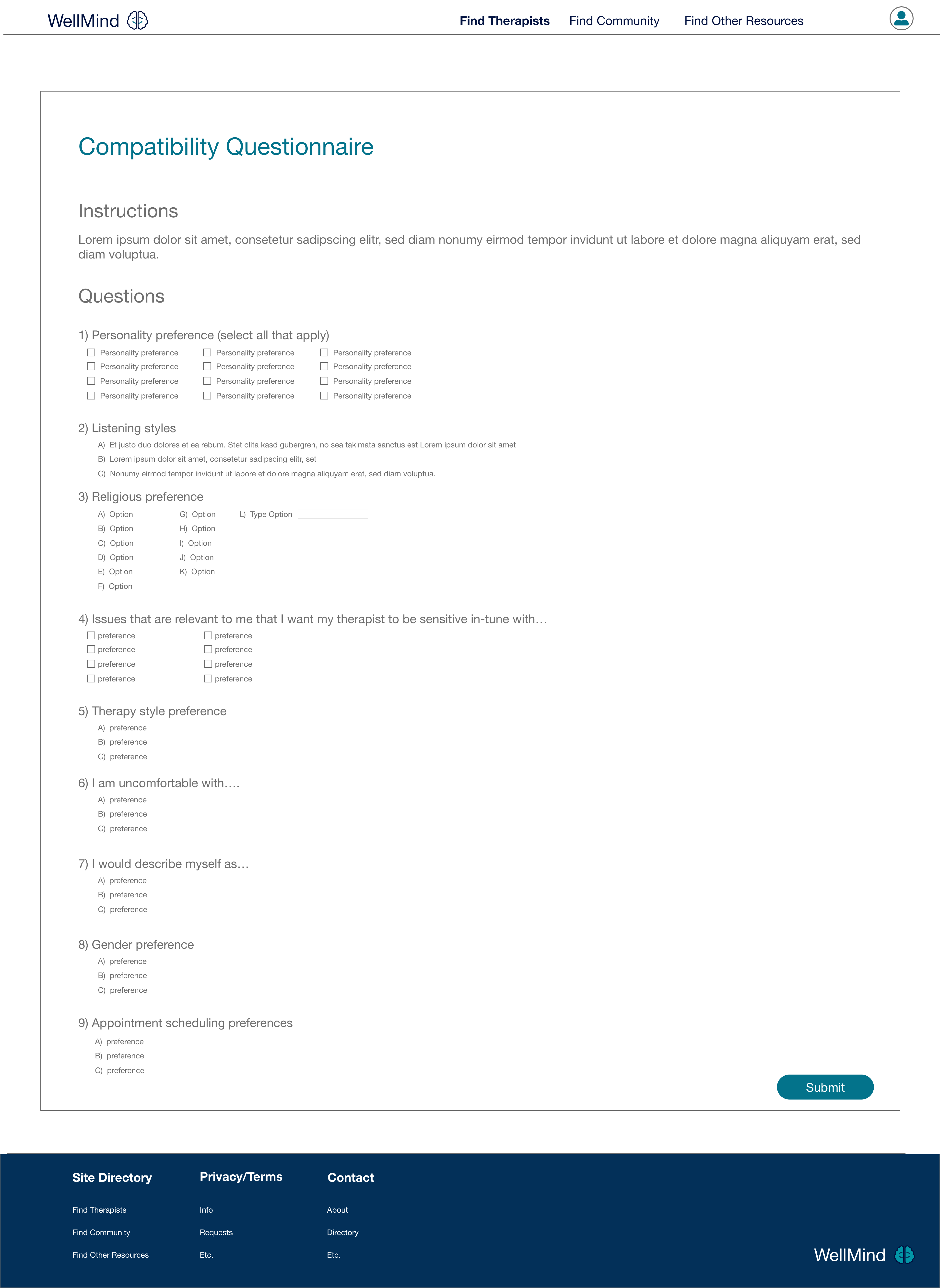
Goals
- Allow users to indicate personal values and desired qualifications of therapist and potential detractors
Compatibility Questionnaire Results
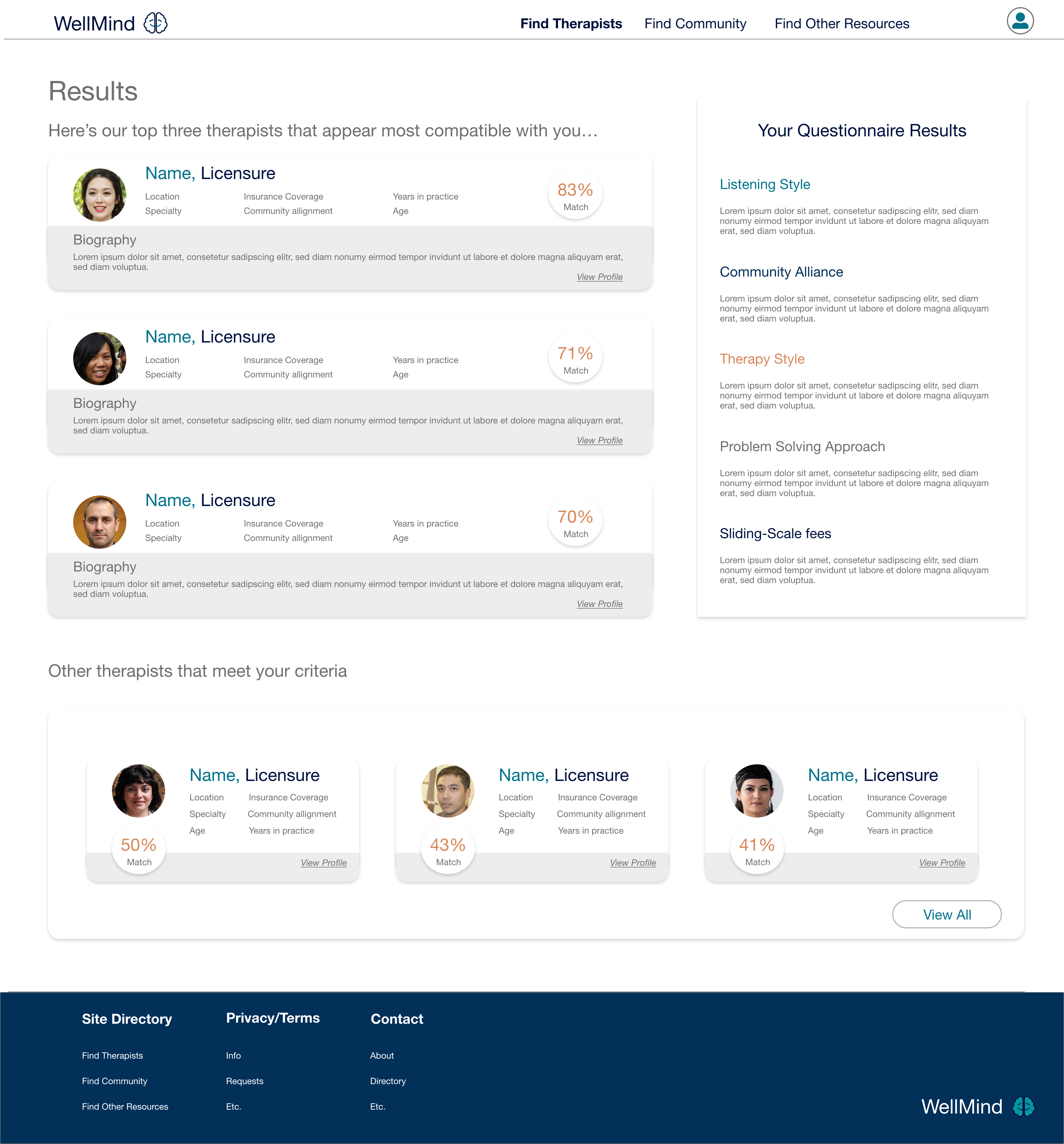
Goals
- Identify therapists that meet the indicated values and needs of the user, as identified in the compatibility questionnaire
- Present information in an orderly way that shows the best-match by quantifying therapist fit through percentage values
- Sneak-peek of therapist bio and introductory information on face-card gives users an idea of the therapist before viewing their profile
Therapist Profile
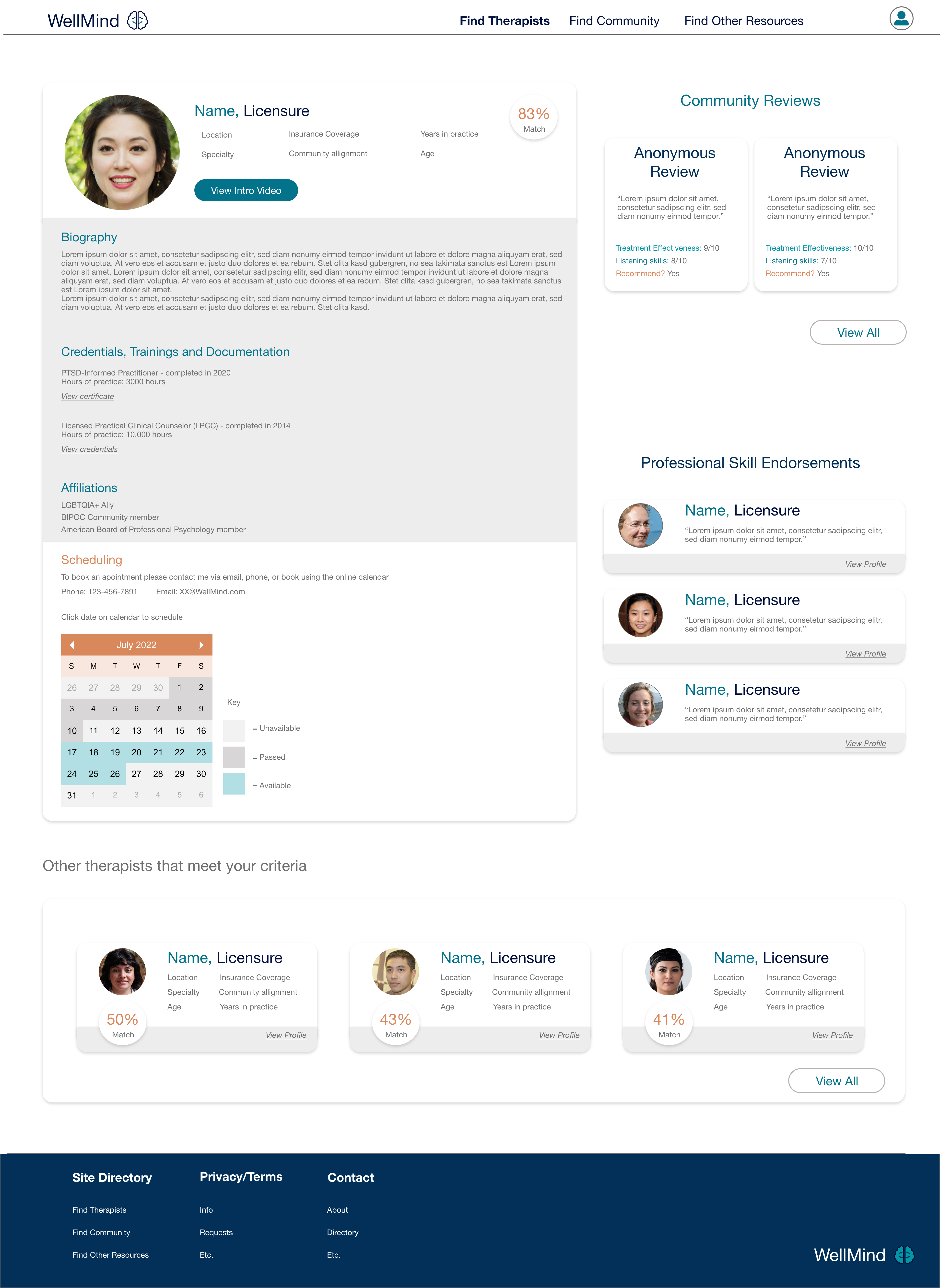
Goals
- Provide detailed information on therapist's credentials, trainings, and group affiliations.
- Offer an opportunity for users to view a video introduction provided by the therapist
- Users can view ratings and reviews of the therapist by other community members, and view professional endorsements from the therapists colleagues
Community
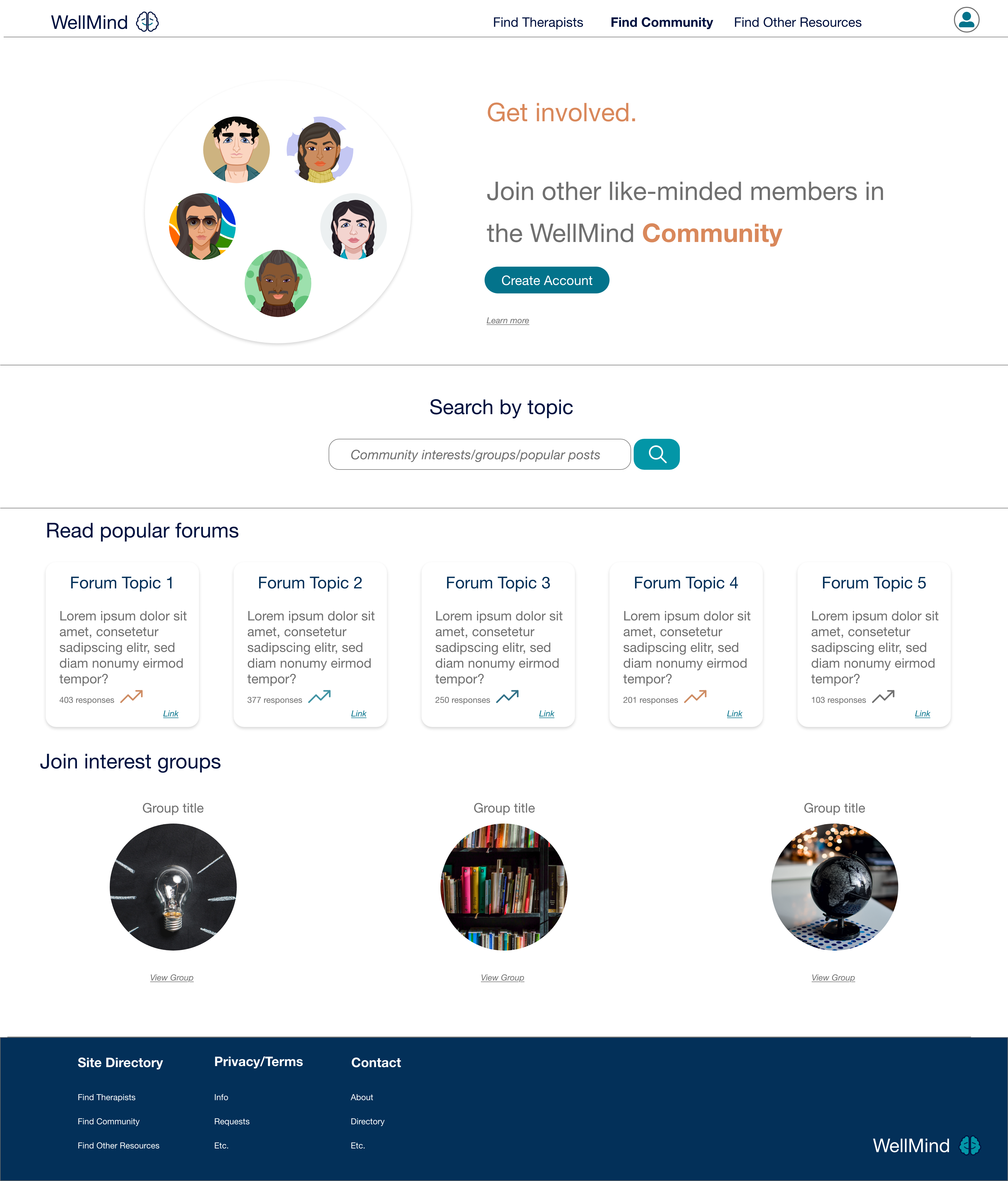
Goals
- Users can search for community groups and forum posts to find their desired way of engagement
- Users can opt to join the community by creating a profile. Anonymity is preserved by enforcing illustrated avatars as profile pictures instead of actual user images
Next Steps in Prototype Design
- Add additonal screens to illustrate user login, posting and commenting on community forums, and scheduling with a provider.
- Create mobile wireframes of screens to accomodate for use on various devices
- Add interaction to prototype design to prepare for user testing
- Develop test plan and conduct usability test of prototype with users that fit target demographic
- Evaluate test results and make design improvements
- Repeat testing and re-design steps as needed







